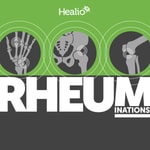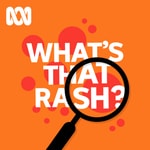The Fellow on Call: The Heme/Onc Podcast – Détails, épisodes et analyse
Détails du podcast
Informations techniques et générales issues du flux RSS du podcast.

The Fellow on Call: The Heme/Onc Podcast
Rouleaux University Medical Center
Fréquence : 1 épisode/9j. Total Éps: 145

We quickly realized we knew very little about hematology and oncology when we started fellowship. Our goal is to bring you the fundamentals, core concepts and important management approaches in our field, driven by the latest evidence and expert opinion. In each episode, we will provide bite-sized, simplified approaches to common questions in a way that is perfect for anyone interested in hematology and oncology, from students and trainees to advanced practice providers and practicing physicians.
Classements récents
Dernières positions dans les classements Apple Podcasts et Spotify.
Apple Podcasts
🇺🇸 États-Unis - medicine
01/08/2025#100🇺🇸 États-Unis - medicine
28/07/2025#93🇬🇧 Grande Bretagne - medicine
27/07/2025#97🇺🇸 États-Unis - medicine
27/07/2025#99🇺🇸 États-Unis - medicine
26/07/2025#78🇺🇸 États-Unis - medicine
25/07/2025#69🇨🇦 Canada - medicine
24/07/2025#63🇺🇸 États-Unis - medicine
24/07/2025#98🇬🇧 Grande Bretagne - medicine
23/07/2025#95🇺🇸 États-Unis - medicine
23/07/2025#98
Spotify
Aucun classement récent disponible
Liens partagés entre épisodes et podcasts
Liens présents dans les descriptions d'épisodes et autres podcasts les utilisant également.
See allQualité et score du flux RSS
Évaluation technique de la qualité et de la structure du flux RSS.
See allScore global : 52%
Historique des publications
Répartition mensuelle des publications d'épisodes au fil des années.
Episode 114: Acute Promyelocytic Leukemia (REBOOT!)
Épisode 114
mercredi 4 septembre 2024 • Durée
By popular demand, our next series that we are excited to share with you is on MDS/AML! As we prepare for the release of the first episode next week, let’s throw it back to Episode 019 in our Heme/Onc Emergencies Series and talk about APL!
Episode contents:
- How do we diagnose APL?
- What are characteristic findings of APL?
- What is the acute management of this disease?
****Have some time and want to make some extra money? Get paid to participate in market research surveys: https://affiliatepanel.members-only.online/FOC_24?utm_campaign=FOC&utm_source=email&utm_medium=email
** Want to review the show notes for this episode and others? Check out our website: https://www.thefellowoncall.com/our-episodes
Love what you hear? Tell a friend and leave a review on our podcast streaming platforms!
Twitter: @TheFellowOnCall
Instagram: @TheFellowOnCall
Listen in on: Apple Podcast, Spotify, and Google Podcast
Episode 113: Sickle Cell Series - “Double Duty: A Doctor's Story of Living with Sickle Cell Disease While Caring for Others”
Épisode 113
mercredi 21 août 2024 • Durée
This week, we have an INCREDIBLE episode for you. We welcome Titilope Fasipe, MD, PhD, who not only is the Co-Director of the Sickle Cell and Thalassemia Program at Texas Children’s and an Assistant Professor in the Department of Pediatrics at the Baylor College of Medicine, she herself also has sickle cell disease! Dr. Fasipe takes us through her life story, from childhood to now. Conducting this interview was such an eye-opening experience for us, and we hope that her message resonates with you when you care for your patients with sickle cell disease.
Contents:
- What it is like growing up with sickle cell disease?
- Pearls to ensure that our practice provides excellent care for our patients with SCD
- Important resources when caring for patients
****Have some time and want to make some extra money? Get paid to participate in market research surveys: https://affiliatepanel.members-only.online/FOC_24?utm_campaign=FOC&utm_source=email&utm_medium=email
** Want to review the show notes for this episode and others? Check out our website: https://www.thefellowoncall.com/our-episodes
Love what you hear? Tell a friend and leave a review on our podcast streaming platforms!
Twitter: @TheFellowOnCall
Instagram: @TheFellowOnCall
Listen in on: Apple Podcast, Spotify, and Google Podcast
New Fellow Bootcamp Series: HIT/HITT
lundi 1 juillet 2024 • Durée
An exciting new academic year is about to begin. We know this can be daunting, especially for our newest hematology/oncology fellows. Over the next two weeks, we re-boot some of our high yield episodes you need to know to prepare for your first days as a new fellow and your nights on call.
Next up: Heparin-induced thrombocytopenia! [Originally episode 071]
Contents:
- What is HIT? How is this different than HITT?
- How do we make this diagnosis?
- How do we treat HIT/HITT?
** Be sure to check out our rotation guide for more show notes and episodes organized by disease type: https://www.thefellowoncall.com/rotation-guides
** Want to review the show notes for this episode and others? Check out our website: https://www.thefellowoncall.com/our-episodes
Love what you hear? Tell a friend and leave a review on our podcast streaming platforms!
Twitter: @TheFellowOnCall
Instagram: @TheFellowOnCall
Listen in on: Apple Podcast, Spotify, and Google Podcast
Episode 022: Pharmacology 101: Capstone
Épisode 22
mercredi 20 juillet 2022 • Durée
We have now covered the fundamentals of pharmacology. This week, we sit down with Renee McAlister, PharmD, BCOP to learn more about the nuances of pharmacology from an expert that does this day in and day out.
*The products/resources we share are our OWN opinions. Naming of resources are not endorsements. We are not sponsored by any of these entities.
Pharmacology Capstone:
* Irritant vs. Vesicant:
** For extravasation, what to do?
*** Not a great general source; would recommend checking institutional guidelines.
*** Different drugs may require a cold vs. warm compress.
*** Some drugs have antidotes - it is best to just look this up when it happens
* Why is there a “cut off time” to get in chemotherapy orders?
** Many hospital pharmacies are not 24 hours, therefore need prep time.
** Many drugs take a long time to prepare!
** A lot verification goes into ensuring that the drugs are correctly ordered, prepared, and handled. Therefore this requires adequate staff to do this safely.
* What does "ideal body weight” mean?
** Calculated by the patient’s sex, height, and the calculated body weight based on this information
** Helps with drug-dosing to ensure that drugs are not over/under-dosed
* What does “AUC” mean?
** Incorporates renal function and the amount of exposure you want the patient to have to the drug. Based on the Calvert equation.
** It is important to re-calculate each time with a new Cr to ensure that this is updated.
** Example: https://reference.medscape.com/calculator/169/carboplatin-auc-dosing-calvert
* What is the role of granulocyte colony-stimulating factor (GCSF)?
** Helps to prevent the risk of infection, especially from endogenous bacteria.
** GCSF helps to minimize the window of neutropenia related to treatment with chemotherapy
** NCCN guidelines (www.nccn.org) provides guidelines about febrile neutropenia risk. A risk >20% means that we build in GCSF administration into the treatments.
*** If risk 10-20% with certain risk factors, we may consider adding GCSF
*** Always look at the paper that was what the approval of the regimen was based off of - they will comment on if/how GCSF was used during the study.
*** If patient develops neutropenic fever during a cycle, if even the drug is not traditionally one that we consider GCSF for, it would be appropriate to consider GCSF for future cycles to decrease the risk of febrile neutropenia.
* What are the different “types” of GCSF?
** Examples:
*** Filgrastim (“Neupogen”) - daily dosing, short-acting GCSF
*** Pegylated-filgrastim (“Neulasta”) - don’t have to give daily dosing; one time shot because it lasts for longer
*** On-body injector (OBI) - a device put on the arm that delivers pegylated- filgastrim at approximately 26 hours after chemotherapy
** Dosing: Very different dosing for all of these medications; pay attention to the dosing!
* Supportive care:
** How do you decide what anti-emetics to include?
*** NCCN supportive care guidelines is a great place to start
*** Regimens with >90% emetic potential should get at least three agents (for example: ddACT, cisplatin based regimens)
**** Example: 5-HT3 receptor antagonists, dexamethasone, olanzapine, and aprepetant
*** Moderate emetic potential (30-90%), add at least 2 drugs
**** Example: 5-HT3 receptor antagonists and dexamethasone
*** Lower risk (30%): usually one one drug
**** Example:5-HT3 receptor antagonists
** If patients have refractory nausea in a cycle, add another agent. When adding drugs, always ensure you are incorporating the patient’s other medical history AND drug-drug interactions
* Pharmacists are an amazing source of information! Please reach out with questions!
Please visit our website (TheFellowOnCall.com) for more information
Twitter: @TheFellowOnCall
Instagram: @TheFellowOnCall
Listen in on: Apple Podcast, Spotify, and Google Podcast
Episode 021: Pharmacology 101: Part 2
Épisode 21
mercredi 13 juillet 2022 • Durée
Picture this: it's day 1 of fellowship and your attending needs you to "get consent for treatment." Huh? How do you educate your patient? We share our tips!
In this episode, we discuss important considerations, including “does my patient need a port?”, “what if drugs extravasate?”, “how do I keep side effects of drug classes straight?!”
*The resources we share are our OWN opinions. Naming of resources are not endorsements. We are not sponsored by any of these entities.
Pharmacology 101:
* Irritant vs. Vesicant:
** Each drug is deemed one of these based on the degree of tissue damage that can result if drug extravasates under skin.
** Vesicant: needs central access
** Irritant: can be given peripherally
* Does my patient need a port/picc?
** If vesicant; for continuous infusions over several days (e.g. 5-FU); some patients with difficult access may request.
*Advantages of ports:
** Easy access for labs
** Easy access for chemotherapy/fluids
* Disadvantages:
** Risk of infection
** Risk of thrombosis
* General overview of chemotherapy side effects:
** Going to target the fastest growing cells in the body, which includes cells that line the GI tract, skin, hair/nails, and blood cells
** Therefore side effects are related:
*** GI: nausea/vomiting, diarrhea (sometimes constipation), decreased appetite, taste changes
*** Low blood counts
**** WBC nadir ~10-14 days (generally), and recover 21-28 days after chemo
* What about unique side effects of chemotherapy classes? How do we keep them straight?
** We love keeping “Chemoman” from the USMLE study days in mind!
* Anthracycline
*** MOA: Topoisomerase inhibitors
*** Ends in “rubicin”
*** You might hear people call doxorubicin the “red devil”
*** Used in lots of cancers
*** Hair loss occurs with this one
*** Known to cause cytopenias and associated with higher nausea potential
*** Unique side effects:
**** Heart failure (always get baseline echo!)
**** Development of MDS and leukemia
* Alkylating agents
** MOA: Drugs add alkyl group to the guanine base of the DNA molecule, preventing linking of strands
** End in “fosfamide”
** fosfamide or cyclophosphamide (AKA cytoxan)
** Used in lots of cancers
** Known to cause cytopenias and hair loss
** Unique side effects:
*** Secondary MDS or leukemia possible
*** Ifosfamide = neurotoxicity = methylene blue antidote
*** Cyclophosphamide = hemorrhagic cystitis due to acrolein byproduct accumulation = prevent by giving mesna to protect bladder
* Antimetabolites
** MOA: Purine analog, pyrimidine analog, folate antagonists; therefore prevent production of base pairs or binds instead of normal base pairs
** End in “abine” - capecitabine, cytarabine, gemcitabine, cladribine, fludarabine
** Also 5-FU and 6-MP in this category so “number followed by dash”
** Unique side effects:
*** Think bone marrow suppression in this category
* Platinum agents
** MOA: Believed to cause cross-linking of DNA
** End in “platin”
** Associated with high risk of neuropathy
** Unique side effects:
*** Cisplatin:
**** Nephrotoxicity
**** Ototoxicity
**** High risk of nausea; need special prophylaxis
*** Carboplatin: cytopenias
*** Oxaliplatin: higher rates GI side effects
* Microtubule agents
** MOA: Impair microtubule function, therefore impacting cell division
** End in “taxel” or vincristine/vinblastine (“V-stine”)
** Unique side effects: Neuropathy
Please visit our website (TheFellowOnCall.com) for more information
Twitter: @TheFellowOnCall
Instagram: @TheFellowOnCall
Listen in on: Apple Podcast, Spotify, and Google Podcast
Episode 020: Pharmacology 101: Part 1
Épisode 20
mercredi 6 juillet 2022 • Durée
Picture this: it's day 1 of fellowship and your attending needs you to "get consent for treatment." Huh? How do you educate your patient? We share our tips!
In this episode, we discuss the fundamentals and some of our favorite resources.
*********The resources we share are our OWN opinions. Naming of resources are not endorsements. We are not sponsored by any of these entities. *********
1) How do you know what regimen to use for a disease?
* www.NCCN.org :
** National Comprehensive Cancer Network
** Free resource, but need to make an account!
** Provides stepwise approach to workup, choosing a regimen, and surveillance information, treatment for refractory disease
* www.HemOnc.org :
**Organized by disease type with long lists of treatment options
** Provides a breakdown of regimen, but also provides the primary literature that lead to the regimen’s approval for use!
**We cannot highlight how important it is to remember to check out the primary literature!
2) Patient education: Use these to drive discussion; you still want to walk your patients through these
* www.Oncolink.org : Ronak’s favorite resource
* www.Chemocare.com : Vivek and Dan’s favorite resource
3) Basic Terminology:
* Cycle: The number of days between one round of treatment until the start of the next; abbreviated with “C”
* Days: Counts the actual days within a cycle; abbreviated with “D”
* Example: C1D1: Cycle 1 of a regimen, day 1 of this cycle
4) Dosing:
* Always have updated height and weight for patients
** Many drugs are dosed based on body surface area (BSA)
** Other drugs use area under the curve (AUC)
* Always get a CMP and CBC prior to giving treatment
5) General categories of cancer therapies:
* Cytotoxic: Kills cells in the body
** Analogous to antibiotics killing bacteria
** Relatively non-specific in terms of what cells they target; but they’re often specific for parts of the cell replication cycle
* Immune therapy: Harness the immune system to attack cancer
** More specific than cytotoxic agents
* Targeted therapy: Drugs made specifically for known mutations
** A cancer with a distinct mutation in a protein is then a target for this drug
** In general:
***“Mab”- antibody targeted for phenotypic expression
***“ib”- small molecule for driver mutation
** Targeted cytotoxic chemotherapy: a monoclonal antibody specific for a mutation linked to very potent chemotherapy
Please visit our website (TheFellowOnCall.com) for more information
Twitter: @TheFellowOnCall
Instagram: @TheFellowOnCall
Listen in on: Apple Podcast, Spotify, and Google Podcast
Episode 019: Heme/Onc Emergencies, Pt. 8: APL
Épisode 19
mercredi 22 juin 2022 • Durée
Emergencies happen in hematology and oncology. This is a fact. But how do we manage these emergencies? Look no further.
In this episode, we’ll talk about one of the key hematologic malignancies that you’ll encounter as a fellow, one that requires immediate action to reduce mortality: acute promyelocytic leukemia (APL or APML)
- Acute Promyelocytic leukemia (APL or APML):
**Stay tuned for our upcoming “part two” and “chemotherapy basics” episodes for more information on non-acute management of this disease
**APL is a true hematologic emergency! Although this is a very curable form of leukemia, it is associated with high rates of severe DIC and high mortality in the period immediately following diagnosis
***Untreated, can see pulmonary or cerebrovascular hemorrhage in up to 40% of patients
***10-20% incidence of hemorrhage-related mortality in the initial period
***Statistically significant increase in mortality at 30 days with just a 12-hour delay in initial hematologist consultation
- Disease basics:
** Rare subtype of AML( <10% of cases)
** Driven by translocations involving the retinoic acid receptor alpha (RARA) on chromosome 17, classically with the promelocytic leukemia gene (PML) on chromosome 15 [i.e. t(15;17)]
***Other non-classical translocations exist, but nearly all involve RARA
**Because of this driver mutation, treatment with a specific isoform of vitamin A: all-trans retinoic acid (ATRA) forces promyelocytes to differentiate and ultimately apoptose
- Initial work up:
**Standard CBC with differential, CMP
** Review smear for characteristic features:
** Large nuclei and scant cytoplasm
** “Folded” appearance to nuclei (like a peach emoji 🍑)
** Auer rods (which tells you blasts are myeloid lineage)
** Heavily granulated cytoplasm (hypergranular form - most common)
***Also a “hypogranular variant,” so like always, make sure to discuss any findings with your friendly neighborhood hematopathologist
**Stat DIC labs:
**PT/aPTT
**Fibrinogen
**Stat PML-RARA FISH (see next section) to look for classic driver mutation and clinch diagnosis
** “Tumor lysis syndrome (TLS) labs”
***LDH
*** Uric acid
**Peripheral flow cytometry
***CD33+, CD 117+
***CD34-, HLA-DR-, CD11a/b/c-
*** Increased side scatter (esp in hypergranular type)
- Acute Management
** Start ATRA: immediate treatment is so important in this disease, and side effect profile is minimal enough that empiric treatment when disease is on the differential is standard of care
**Correct coagulopathies as you detect them
***Keep fibrinogen > 110 mg/dL
*** Keep INR < 2.0
*** Keep plt > 30k/uL
References:
Gulam Abbas Manji, Samira Khan Manji, Sheetal Karne, and Jeff Chao “Time to ATRA in suspected newly diagnosed acute promyelocytic leukemia and association with early death rate at a non-cancer center institution: Are we meeting the target?” Journal of Clinical Oncology 2012 30:15_suppl, 6615-6615 - impact of treatment delay on 30-day mortality
Eytan M. Stein, Neerav Shukla, Jessica K. Altman “Chapter 20: Acute Myeloid Leukemia” section on acute promyelocytic leukemia ASH SAP 7th Ed pp588-590. DOI: 10.1182/ashsap7.chapter20
Warrell RP Jr, de Thé H, Wang ZY, Degos L. Acute promyelocytic leukemia. N Engl J Med. 1993 Jul 15;329(3):177-89. doi: 10.1056/NEJM199307153290307. PMID: 8515790. - Great review of the basics in NEJM from the early 2000s
Sanz MA, Fenaux P, Tallman MS, Estey EH, Löwenberg B, Naoe T, Lengfelder E, Döhner H, Burnett AK, Chen SJ, Mathews V, Iland H, Rego E, Kantarjian H, Adès L, Avvisati G, Montesinos P, Platzbecker U, Ravandi F, Russell NH, Lo-Coco F. Management of acute promyelocytic leukemia: updated recommendations from an expert panel of the European LeukemiaNet. Blood. 2019 Apr 11;133(15):1630-1643. doi: 10.1182/blood-2019-01-894980. Epub 2019 Feb 25. PMID: 30803991. - Updated treatment guidelines (more on this in “Part 2” to come)
Please visit our website (TheFellowOnCall.com) for more information
Twitter: @TheFellowOnCall
Instagram: @TheFellowOnCall
Listen in on: Apple Podcast, Spotify, and Google Podcast
Episode 018: Heme/Onc Emergencies, Pt. 7: TTP
Épisode 18
vendredi 17 juin 2022 • Durée
Emergencies happen in hematology and oncology. This is a fact. But how do we manage these emergencies? Look no further. In this episode, we talk all about our fourth hematologic emergency: thrombotic thrombocytopenic purpura (TTP).
Thrombotic thrombocytopenic purpura (TTP):
- Be sure to check out episode 009 on thrombocytopenia for a general approach and differential!
- New anemia and thrombocytopenia should raise concerns for TTP!
Workup:
- Peripheral smear - concern for schistocytes. Look at this first! Example of these cells from ASH image bank here
- ADAMTS13 level - always draw ASAP before any intervention
- Repeat CBC
- Reticulocyte count - will have elevated retic count
- Citrated platelet count
- CMP
- PT, PTT, INR
- Fibrinogen
- Haptoglobin
- LDH
- Viral serologies
Clinical manifestations:
- Fever, Anemia, Thrombocytopenia, Renal (AKI), Altered Mental Status
- If you see this - the patient is in bad shape
Mechanism:
- Tiny blood clots form in the body, causing platelet shearing
- Loss of ADAMTS13 - This protein normally is responsible for chopping up von Willebrand’s factor (vWF)
- In the absence of ADAMTS13, vWF multimers are extra long, therefore interacting with platelets/collagen more and causing activation of platelets and clotting system
- This causes red blood cell shearing due to small vessel microthrombi (brain, kidneys, heart)
- Cytokine release causes fevers
Management:
- Do not reflexively transfuse platelets; can make situation worse
- PLASMIC Score: helps to stratify likelihood of TTP; MDCalc link (https://www.mdcalc.com/plasmic-score-ttp)
Treatment:
- Plasma exchange: replacing ADATMS13-deficient plasma with ADAMTS13-rich plasma
- This is different than plasmapheresis, where we replace plasma with albumin
- Steroids: 1mg/kg prednisone daily to stop auto-antibody (against ADAMTS13) production
- Confirm with ADAMTS13 levels; if <10%, this is confirmatory. This is why this is the FIRST step that we just send off as soon as TTP is suspected
- IF YOU DON’T HAVE ACCESS TO PLASMA EXCHANGE: can administer FFP until you can get them to a center than can do plasma exchange
- Caplacizumab: reserved for patients with severe neurological dysfunction, stroke, or myocardial infarction. Check out the NEJM paper on this (below)!
Microangioathic hemolytic anemia (MAHA):
- Umbrella term for red blood cells shearing in the small blood vessels; TTP is one example of a MAHA
References:
https://ashpublications.org/blood/article/129/21/2836/36273/Thrombotic-thrombocytopenic-purpura - great review article from ASH on TTP
https://www.nejm.org/doi/10.1056/NEJMoa1806311 - NEJM paper on caplacizumab
Please visit our website (TheFellowOnCall.com) for more information
Twitter: @TheFellowOnCall
Instagram: @TheFellowOnCall
Listen in on: Apple Podcast, Spotify, and Google Podcast
Episode 017: Heme/Onc Emergencies, Pt. 6: Heparin-Induced Thrombocytopenia (HIT)
Épisode 17
mercredi 15 juin 2022 • Durée
Emergencies happen in hematology and oncology. This is a fact. But how do we manage these emergencies? Look no further. In this episode, we talk all about our third hematologic emergency: heparin-induced thrombocytopenia (HIT)!
Be sure to check out episode 009 on thrombocytopenia for a general approach and differential!
HIT:
- Any time a patient with heparin exposure and now with a new thrombotic event, you need to think about HIT!
What is HIT?
- Type 1: a transient drop in platelets after heparin is started
- Type 2:
**The scary one! Antibody-mediated process
**Heparin molecules bind to platelet-factor 4 (PF4)
**This complex activates platelets, which then further releases more PF4 from the platelets
What is the difference between HIT and HITT?
- HITT is when there is also thrombosis (HIT + Clot)
Why is this more common in the cardiac ICU?
- It is believed that IgM interacts with ultra-long complexes, which heparin is
- Lots of heparin is required for cardiac surgery
- Therefore lots of exposure to heparin increases likelihood, increasing likelihood for IgM to IgG class-switching; HIT is IgG-mediated process
** Remember - since this is antibody-mediated, therefore it takes a few days for the antibodies to form in patient with a new diagnosis of HIT!
How to stratify?
4-T score (MDCalc Link: https://www.mdcalc.com/4ts-score-heparin-induced-thrombocytopenia)
Workup:
- Sent HIT ELISA test in patient with high suspicion
- ELISA just suggests if the HIT antibody is present
- If ELISA positive, then do confirmatory assay, i.e., is this antibody actually doing anything, is the "serotonin-release assay”
- Send 4 extremity dopplers to look for thrombosis
- STOP heparin/heparin-derived products and SWITCH anticoagulant, such as argatroban, fondaparinux, bivalirudin (do not wait for a positive test if your suspicion is high enough!)
If HIT positive:
- Add heparin to their allergy list
- Continue anticoagulation until platelets are recovered (>150K)
- Continue anticoagulation for 3-6 months for patients with HITT
Words of wisdom: If patient comes from outside hospital and starts having decreasing platelets, consider HIT in your differential!
References:
https://ashpublications.org/blood/article/119/10/2209/29530/How-I-treat-heparin-induced-thrombocytopenia- great review article from ASH on HIT
Please visit our website (TheFellowOnCall.com) for more information
Twitter: @TheFellowOnCall
Instagram: @TheFellowOnCall
Listen in on: Apple Podcast, Spotify, and Google Podcast
Episode 016: Heme/Onc Emergencies, Pt. 5: DIC and Intro to TMAs
Épisode 16
mercredi 25 mai 2022 • Durée
Emergencies happen in hematology and oncology. This is a fact. But how do we manage these emergencies? Look no further. In this episode, we talk all about our second hematologic emergency: disseminated intravascular coagulation (DIC) with an added bonus of an intro to thrombotic microangiopathic anemias (TMAs).
Be sure to check out episode 009 on thrombocytopenia for a general approach and differential!
Disseminated intravascular coagulation (DIC):
Workup:
CBC
CMP
PT, PTT, INR
Fibrinogen
Peripheral smear - concern for schistocytes. Example of these cells from ASH image bank: https://imagebank.hematology.org/image/60306/schistocytes?type=upload#:~:text=A%20schistocyte%20is%20present%20in,angles%20and%2For%20straight%20borders.
Basic mechanism of DIC is consumption of clotting factors leading to coagulopathy
Need to be weary of thrombotic microangiopathy: Small blood clots forming in the small vessels leading to endothelial damage, which cause shear stress on the RBCs, which then break down into a schistocyte (AKA triangulocyte or helmet cell)
Examples: thrombotic thrombocytopenic purpura (TTP) and hemolytic uremic syndrome (HUS)
Management (our opinion!):
- Repeat coags q4-6 hours initially (but base interval based on patient) NOTE: INR Is NOT a good assessment of “clotting status” in these situations
- Repeat fibrinogen q4-6 hours initially (but base interval based on patient); keep fibrinogen >100 with cryoprecipitate in more stable patients; consider higher thresholds for more acutely ill patients (such as >150)
- Repeat CBC q6-8 hours initially; can provide platelets if low, especially if they are bleeding
- Workup and treatment for trigger of DIC (infection, trauma, medications, etc.)
How does cirrhosis affect data interpretation?
- Use clinical context to determine if labs are acutely abnormal or if they have signs/symptoms to suggest underlying liver dysfunction
- In the acute setting, always just replace what is missing!
How can you tell the difference between nutritional deficiencies vs. consumption (as in with DIC?)
- Factor activity levels! Consider checking: Factor 8 (made in endothelium), Factor 5 (Vit K independent), Factor 7 (vitamin K dependent)
- If all down, then consider DIC
- If Vit K-dependent low, then nutritional deficiency
Reference:
https://ashpublications.org/blood/article/131/8/845/104418/How-I-treat-disseminated-intravascular-coagulation - Great How I Treat article from Blood
Please visit our website (TheFellowOnCall.com) for more information
Twitter: @TheFellowOnCall
Instagram: @TheFellowOnCall
Listen in on: Apple Podcast, Spotify, and Google Podcast









